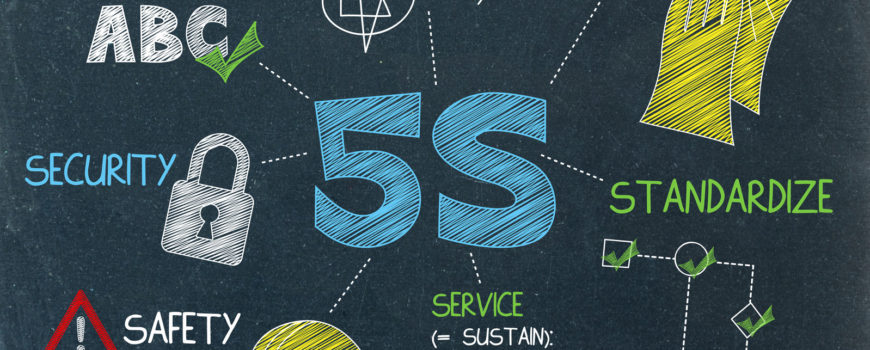5S is lean Six Sigma approach designed to reduce waste and maximize productivity by keeping an orderly workplace and achieving consistent results that can be checked via visual cues. Implementation organizes the workplace within its existing framework, and this is the first step toward a lean Six Sigma effort. However, in an advanced manufacturing environment, there are many benefits to adopting these practices outside the formal Six Sigma system.
Benefits of 5S in an Advanced Manufacturing Environment
Developing consistency and organization leads to a conscientious attitude and a safer, more efficient workplace. Conversely, when defects and waste aren’t measured and controlled, costs begin to pile up. Here are some examples:
- Output falls short due to variations between crews.
- Utilization is reduced due to longer-than-expected product changeovers.
- Missing parts make it necessary to rush in a new one
Companies try to guide improvements via Six Sigma, Lean, or Total Productive Maintenance programs. However, studies show that up to two-thirds of such efforts fall below the expectations of stakeholders. Learning these methods is easy, but putting into action is not due to the following:
- Process improvements decline.
- Continuous improvement isn’t realized or prioritized.
- The initiative isn’t global enough.
5S is One Solution
Companies like Danaher and Toyota went through the 5S program to develop positive cultures. 5S engages people to contribute to a visually-oriented organization, where cleanliness facilitates increased safety, productivity, and quality.
5S forms the foundation for more disciplined actions. Workers who put their tools back in place are more likely to follow production standards. Its visual nature makes it easy to spot items that are out of place. It lays the way for continuous improvement and provides:
- Cleaner, safer work areas with fewer tripping hazards
- Less wasted time searching for tools and materials that are more accessible
- Unneeded items are eliminated so that less floor space is required
- Improved self-discipline fostered by the visual nature of 5S, which makes abnormal conditions stand out
- Improved culture due to 5S-motivated teamwork and motivation
What are the 5S’s?
The components of 5S are sorting, simplifying, systemic cleaning, standardizing and sustaining.
- Sorting activities eliminate unnecessary items from work areas in order to clean it.
- Simplifying arranges the work area for safety and efficiency.
- Systematic daily inspection of facility and equipment helps determine if corrective action is needed.
- Standardizing makes abnormal conditions stand out so that the workplace organization is sustainable.
- Sustaining aims to keep current improvements to allow further progress to be made.
Implementing 5S
5S is not a housekeeping activity. Instead, 5S has to be a team effort and everyone should be able to tell instantly what’s out of place. With organization forming the crux of 5S, it’s vital to start with getting rid of unneeded items.
Sorting
During this phase, employees can sort and clear their work areas. This can take weeks in each department as everyone works to establish criteria for what to throw out. Much like cleaning your closet, anything not used for a year can be removed or put in a holding area. Disposing of uneeded items may mean transferring them elsewhere in the company, selling or discarding them. Then, the employee can conduct an initial cleaning.
Simplifying
Simplying gives everything a home and places each item in order of efficiency. Frequently-used items, for example, have to be close to where they’re used as possible. To accomplish this task:
- Pick a spot for each item arranged in order of frequency of use and take safety precautions into account.
- Label items so that there’s a home for everything.
- Create a process to replenish supplies.
- Document the equipment, layout and plan to replace supplies.
Systematic Cleaning
Systematic cleaning creates a document that enables inspection of the area. Everything should be swept, mopped and dusted and kept neat and clean with rags or brooms. Daily cleaning and inspections should be easy. Inspections include:
- Identify points to check.
- Define acceptable condition.
- Mark equipment that has visual indicators such as gauges.
- Conduct cleaning and visual check parameters.
Standardizing
Standardizing ensures that all workers understand the expectations.It is the workplace team that establishes the set of standards they will follow. It’s crucial that everyone has some involvement. Here are the steps to standardize the 5S processes.
- Establish a checklist for the work area. The checklist should show everything the team checks during self-audits.
- A multi-level audit system helps to make sure that the organization fulfills the overarching 5S goal of sustaining the work areas so that the system can evolve to more stringent controls and process improvements.
- Establish and document a single source of truth as to the 5S processes for the company
- Add new standards to the master document.
Sustaining
Sustaining is considered the hardest “S.” However, it shouldn’t be if you let the 5S system work for your advanced manufacturing company. At this point, you should have engaged everyone in the work area during 5S activities and have a “tell at a glance” visual workplace. If this is so, then sustaining is much easier. That is important, but not sufficient. A more systematic way to prevent backsliding and to foster continuous improvement is needed. The steps of sustaining are:
- Define the 5S overall grade.
- Perform routine 5S checks via the 5S checklist.
- Address new opportunities that are uncovered during routine checks.
- Conduct scheduled, routine checks by supervisors or someone not directly from the work area in the machine shop that is being inspected.
Perform higher-level audits to evaluate how well the 5S system is working overall. For example, are there systemic issues with sustaining 5S? Often, the company’s safety committee is an excellent body for conducting these audits.
When you develop sustaining activities everything that follows becomes part of the 5S process and future refinements. When items are returned to their place, the entire operation is smoother. When something is out of place its cause is probably that the organization needs to be tweaked so that it’s convenient. The work team should be the ones who safeguard the sustainability of 5S and improve morale, safety, and productivity.



